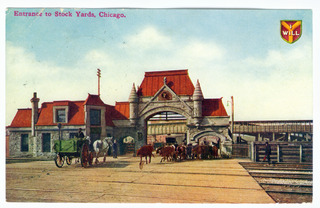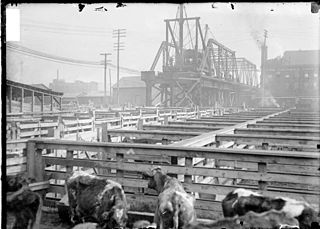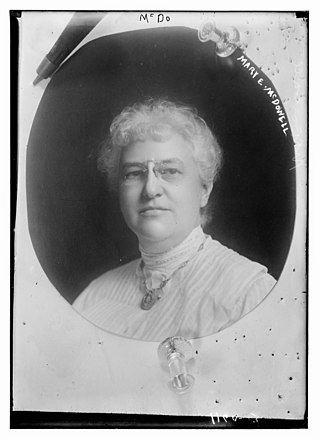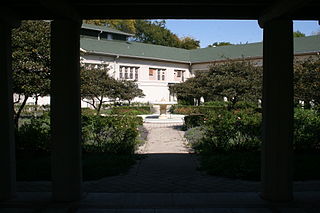- Chicago Union Stock Yards fire (1910), 21 firefighters and 3 civilians killed
- Chicago Union Stock Yards fire (1934), second-most destructive Chicago fire in terms of property loss

The Union Pacific Railroad, legally Union Pacific Railroad Company and often called simply Union Pacific, is a freight-hauling railroad that operates 8,300 locomotives over 32,200 miles (51,800 km) routes in 23 U.S. states west of Chicago and New Orleans. Union Pacific is the second largest railroad in the United States after BNSF, with which it shares a duopoly on transcontinental freight rail lines in the Western, Midwestern and Southern United States.

The International Amphitheatre was an indoor arena located in Chicago, Illinois, that opened in 1934 and was demolished in 1999. It was located on the west side of Halsted Street, at 42nd Street, on the city's south side, in the Canaryville neighborhood, adjacent to the Union Stock Yards.

The Chicago Union Stock Yards fire occurred from December 22 to December 23, 1910 and resulted in the deaths of twenty-one Chicago Fire Department firemen.

The Union Stock Yard & Transit Co., or The Yards, was the meatpacking district in Chicago for more than a century, starting in 1865. The district was operated by a group of railroad companies that acquired marshland and turned it into a centralized processing area. By the 1890s, the railroad capital behind the Union Stockyards was Vanderbilt money. The Union Stockyards operated in the New City community area for 106 years, helping Chicago become known as the "hog butcher for the world," the center of the American meatpacking industry for decades. The yards became inspiration for literature, and social reform.

New City is one of Chicago's 77 official community areas, located on the southwest side of the city in the South Side district. It contains the neighborhoods of Canaryville and Back of the Yards.
The South Omaha Terminal Railway in Omaha, Nebraska was a subsidiary of the Union Stock Yards Company of Omaha. Until the separate railroad company was created in July 1927, the trackage, about 17 miles (27 km), was owned and operated directly by the Union Stock Yards Company of Omaha. On April 4, 1978, an Interstate Commerce Commission emergency service order was issued at which time the Brandon Corporation took over service.

The Union Stock Yard Gate, located on Exchange Avenue at Peoria Street, was the entrance to the famous Union Stock Yards in Chicago. The gate was designed by Burnham and Root around 1875, and is the only significant structural element of the stock yards to survive. It was designated a National Historic Landmark in 1981. The plaza surrounding the gate also includes the city's principal memorial to its firefighters.

Dexter Park was a horse race track in Chicago built in the years following the Civil War. It was named for a gelding and trotter who had set world records for the mile and inspired the naming of several new towns including Dexter, Missouri and Dexter, Texas. The track's formal opening was held in July 1867.
Stockyard or Stockyards may refer to:

Bubbly Creek is the nickname given to the South Fork of the South Branch of the Chicago River. It runs entirely within the city of Chicago, Illinois, U.S. It marks the boundary between the Bridgeport and McKinley Park community areas of the city. The creek derives its name from the gases bubbling out of the riverbed from the decomposition of blood and entrails dumped into the river in the early 20th century by the local meatpacking businesses surrounding the Union Stock Yards directly south of the creek's endpoint at Pershing Road. It was brought to notoriety by Upton Sinclair in his exposé on the American meat packing industry titled The Jungle.

The Union Stock Yards Company of Omaha was a 90-year-old company first founded in South Omaha, Nebraska in 1878 by John A. Smiley. After being moved to Council Bluffs, Iowa and dissolved within a year, the company was reorganized and moved to South Omaha in 1883. Six local businessmen responded to a request by Wyoming cattle baron Alexander Swan showing interest in a livestock market closer than the Union Stock Yards in Chicago, Illinois. The Company's Union Stockyards in South Omaha were once a fierce rival of Chicago's Union Stock Yards. The Union Stock Yards Company of Omaha was bought out in 1973.
The Union Stockyards of Omaha, Nebraska, were founded in 1883 in South Omaha by the Union Stock Yards Company of Omaha. A fierce rival of Chicago's Union Stock Yards, the Omaha Union Stockyards were third in the United States for production by 1890. In 1947 they were second to Chicago in the world. Omaha overtook Chicago as the nation's largest livestock market and meat packing industry center in 1955, a title which it held onto until 1971. The 116-year-old institution closed in 1999. The Livestock Exchange Building was listed on the National Register of Historic Places in 1999.
James Patrick O'Leary was a gambling boss and saloon owner in Chicago. His parents were Patrick and Irish-born Catherine O'Leary, in whose barn the Great Chicago Fire is alleged to have begun.

The South Side Elevated Railroad was the first elevated rapid transit line in Chicago, Illinois. The line ran from downtown Chicago to Jackson Park, with branches to Englewood, Normal Park, Kenwood, and the Union Stock Yards. The first 3.6 miles (5.8 km) of the line opened on June 6, 1892, and much of its route is still used today as part of the Green Line of the Chicago "L" system.

The Chicago Junction Railway operated a switching and terminal railroad in Chicago, connecting the Union Stock Yards with most other railroads in the city. It also briefly operated an outer belt, which became the Indiana Harbor Belt Railroad in 1907. The New York Central Railroad acquired control of the company in 1922 and leased it to subsidiary Chicago River and Indiana Railroad. The line is now owned and operated by the Norfolk Southern Railway.

The Kenwood branch was a rapid transit line which was part of the Chicago 'L' system from 1907 to 1957. The branch served the Kenwood neighborhood of Chicago and consisted of six elevated stations. It opened on September 20, 1907 and closed on December 1, 1957.

The Stock Yards branch was a rapid transit line which was part of the Chicago 'L' system from 1908 to 1957. The branch served the Union Stock Yards and the Canaryville neighborhood of Chicago and consisted of eight elevated stations. It opened on April 8, 1908, and closed on October 6, 1957.

Mary Eliza McDowell was an American social reformer and prominent figure in the Chicago Settlement movement.

Fuller Park is a public park at 331 W. 45th Street in the neighborhood of the same name in Chicago, Illinois, United States. The park was one of several built by the South Park Commission in the early 20th century to provide parks in dense and poor South Side Chicago neighborhoods which lacked them. While most of the South Park Commission parks opened in the mid-1900s, work on Fuller Park did not begin until 1910 due to a dispute over its location, and its facilities gradually opened over the next four years. The park was named for Melville Fuller, an Illinois native and former Chief Justice of the United States. The South Park Commission designed the park's landscape in a similar style to their earlier parks, which had been designed by the Olmsted Brothers; D. H. Burnham and Company designed its buildings, as they had for the earlier parks. The park originally included a Beaux-Arts fieldhouse, a gymnasium, a bathhouse, a grandstand, and a running track and walking paths. Fuller Park was first settled by Irish immigrants in the later 1860s after the Union Stock Yards opened on Christmas Day 1865. This area became a part of the Lake Township area and after the Great Chicago Fire of 1871 and the opening of the Lake Shore & Michigan Southern Railroad the area flourished into a community.

The Chicago Union Stock Yards fire of 1934 was the second-most destructive fire in the city's history, after the Great Chicago Fire of 1871, in terms of property damage and buildings lost. The Union Stock Yards of Chicago, Illinois in the United States were, at the time, the commercial butchering and meatpacking center of the Midwest. The financial cost of the fire, which began Saturday, May 19, 1934, was estimated at US$8 million. Six square blocks were destroyed. One employee and thousands of animals died.